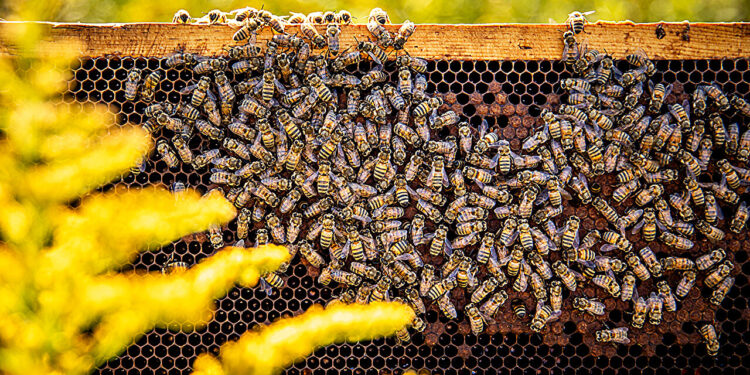Bees do best when they have access to a variety of natural pollens. Credit: Michelle Hassel
In a new study, researchers at the University of Illinois at Urbana-Champaign tackled a vexing problem: How do nutritional stress, viral infections, and pesticide exposure together influence bee survival? By looking at these three stressors together, the scientists found that good nutrition improves bees’ resilience to other threats.
Their conclusions are detailed in the review Total Environmental Science.
“Multiple stressors are often detrimental to survival,” said Edward Hsieh, a graduate student who led the research with Adam Dolezal, a professor of entomology at the University of Illinois. “However, it’s always context-dependent, and you have to be aware of all of these factors when trying to make general statements about how interactive effects affect bees.”
Most studies focus on one or two factors at a time, Hsieh said. They’ll look at the interaction between poor diet and pesticide exposure, for example, or between pesticides and viral infections. But no previous studies have looked at how all three factors contribute to bee declines, probably because it’s quite difficult.
Understanding how bees react to all the agricultural chemicals they encounter is already a complicated task, Dolezal said.
“Some insecticides are more effective against some insects than others, but they tend to be more deadly than fungicides or herbicides,” he said. “Some fungicides, however, are known to make insecticides more toxic to insects.”
Environmentalists worry that creating narrow strips of pollinator habitat near agricultural fields could serve as an “ecological trap” for bees, enticing them to forage on flowers only to kill them with pesticides. A new study finds that high-quality floral resources boost honey bees’ resilience to pesticide exposure and infection with a deadly virus. Credit: Iowa State University, left, and Lynn Betts, right
For the new study, the team studied pollen collected by honeybees visiting small plots of restored prairie bordering agricultural fields in Iowa. The researchers used the maximum levels of insecticides and fungicides detected in the pollen grains collected by the bees as a guide to likely chemical exposures in nature.
In a series of experiments, Hsieh exposed groups of caged bees to different dietary, viral, and/or chemical treatments. The bees were fed artificial or natural pollen. Agricultural pesticides included the organophosphate chlorpyrifos, the pyrethroid lambda-cyhalothrin, or the neonicotinoid thiamethoxam.
Hsieh also infected some of the caged bees with the Israeli acute paralysis virus, one of several viruses known to contribute to the collapse of bee colonies worldwide.
The experiments yielded some obvious results and some unexpected ones, Dolezal said.
“We found that with artificial pollen, if bees are exposed to the virus, many of them die. And if you expose them to the virus and pesticides at the same time, even more die,” he said. “However, if you do the exact same experiment but give them a better diet, you get a very different result.”
The researchers found that bees exposed to the virus and fed natural pollen still had higher mortality. But fewer bees died when they were also exposed to a mixture of chlorpyrifos and a fungicide.
“Bees have this innate ability to handle stress. If you give them a little bit of stress, like a low-level exposure to a pesticide, it can help them handle a bigger stress from a pathogen like a virus,” Dolezal said. “However, that only works if they have the nutritional resources to do it.”
Illinois entomology professor Adam Dolezal, right, and graduate student Edward Hsieh have found that pollen from natural sources improves the resilience of bees when exposed to agricultural chemicals and infected with the Israeli acute paralysis virus. Credit: Michelle Hassel
Researchers caution that this does not mean chemical exposures don’t matter.
“Different pesticides have different molecular targets and have different effects,” Dolezal said. “It’s not acceptable for bees to be exposed to a small amount of any pesticide. It depends on the chemical.”
These results offer some reassurance that providing high-quality grassland habitat near agricultural sites does not create an “ecological trap,” attracting bees to flowers only to kill them with agricultural chemicals.
“This study shows that bees are very resistant to the interaction between pesticides and viruses if they have good nutrition,” Dolezal said. “However, we don’t want people to conclude that pesticides are not a major problem for bees.”
Pesticides, alone or in combination with viruses, are in most cases harmful to bees.
“But it’s rewarding to know that providing high-quality habitat can at least increase their resilience to these stressors,” Hsieh said.
More information:
Edward M. Hsieh et al., Nutrition, pesticide exposure, and viral infection interact to produce context-dependent effects in honeybees (Apis mellifera), The science of the total environment (2024). DOI: 10.1016/j.scitotenv.2024.175125
Provided by the University of Illinois at Urbana-Champaign
Quote:Study finds good nutrition boosts bees’ resilience against pesticides, viruses (2024, September 24) retrieved September 24, 2024 from
This document is subject to copyright. Apart from any fair dealing for the purpose of private study or research, no part may be reproduced without written permission. The content is provided for informational purposes only.



